Що таке Meshchain Ai? Все, що вам потрібно знати про MCC
MeshChain AI (MCC) - це децентралізована платформа для ефективної обробки навантаження штучного інтелекту через глобальні вузлові мережі.Традиційне хмарне обчислення в значній мірі ґрунтується на централізованих центрах обробки даних, які контролюються кількома великими сутностями, що викликає виклики, такі як обмежена масштабованість, високі операційні витрати, вразливість до відключень та ризики для конфіденційності даних. Ці централізовані моделі можуть пригнічувати інновації та обмежувати доступ менших розробників та бізнесу до критичних обчислювальних ресурсів. Для вирішення цих обмежень виникає новий підхід, який поєднує потужність блокчейну з штучним інтелектом для створення децентралізованої, стійкої та більш інклюзивної інфраструктури. Один з проектів, що вирішує ці обмеження, - це Meshchain Ai, яка має на меті децентралізувати обчислення штучного інтелекту.
Що таке Meshchain Ai (MCC)?
Meshchain Ai було офіційно запущено 11 грудня 2024 року командою, яка діє між Гонконгом та Сполученими Штатами. Розроблений під керівництвом BlockNet Technologies, Meshchain має на меті поєднати масштабованість та низькі витрати інфраструктури блокчейн з обчислювальними вимогами штучного інтелекту. Його власний токен, MCC, працює на Binance Smart Chain (BSC) за стандартом BEP-20, утворюючи основу децентралізованої мережі інфраструктури штучного інтелекту.
Meshchain Ai було співзасновано експертами зі штучного інтелекту та блокчейну, зокрема д-р Емілі Тран, Джеймс Лю та Сара Патель, які поєднали понад 30 років досвіду, щоб очолити інновації в децентралізованих рішеннях зі штучного інтелекту.
У 4 кварталі 2024 року Meshchain почав запускати свій браузерний вузол для легкого обчислювання та телеграм-кампанію з випуску токенів, щоб залучити спільноту. Випуск порталу користувача дозволив користувачам управляти своїми обчислювальними внесками та балансами винагород. На початку 2025 року Meshchain представив програмне забезпечення та відведене апаратне забезпечення, запустив повні токеноміку для токена MCC та вніс його до децентралізованих бірж. Також були впроваджені покращені функції безпеки, включаючи шифрування та багатофакторну аутентифікацію.
У другому кварталі 2025 року Meshchain розширилася на мобільні пристрої, дозволяючи користувачам управляти своїми вузлами та винагородами за допомогою додатка. Платформа представила функціональність стейкінгу та планувала включити MCC до централізованих бірж. Приблизно в цей час Meshchain відкрив мережу для розробників штучного інтелекту для подачі завдань та запустив свою Програму для споживачів ресурсів. Третій та четвертий квартали 2025 року фокусувались на масштабуванні екосистеми як за кількістю операторів вузлів, так і партнерством з компаніями зі штучним інтелектом.
На початку 2026 року Meshchain планує оптимізувати свою інфраструктуру для складних навантажень штучного інтелекту, таких як глибоке навчання, і ввести паралелізацію для обробки великого масштабу. З 2027 по 2030 рік дорожня карта спрямована на рішення підприємства класу підприємств та міжланцюжкову взаємодію, з метою встановлення Meshchain як глобального децентралізованого комп'ютерного гіганта для застосувань штучного інтелекту. Meshchain залишається відданим прозорості, децентралізації та зменшенню витрат на обчислення штучного інтелекту протягом всього свого розвитку.
Як працює Meshchain Ai? Архітектура та системний дизайн
MeshChain Ai розроблений як децентралізована обчислювальна інфраструктура, оптимізована для робочих навантажень штучного інтелекту. Ядром цієї системи є MeshChain Network, глобально розподілена обчислювальна тканина, яка з'єднує інженерів і розробників штучного інтелекту з постачальниками ресурсів за допомогою фреймворку, захищеного блокчейном. Замість того, щоб покладатися на централізованих хмарних провайдерів, MeshChain використовує незадіяні обчислювальні потужності з особистих пристроїв, розширень браузера та виділених апаратних вузлів. Ця децентралізована мережа фізичної інфраструктури (DePIN) забезпечує доступність, безпеку та масштабованість для навчання та висновків моделей штучного інтелекту. Мережа структурована на серію оркестрованих компонентів, які відповідають за розподіл завдань, обчислення, перевірку та агрегацію кінцевих результатів.
Коли інженер зі штучного інтелекту подає завдання, таке як навчання моделі машинного навчання, воно надсилається до оркестратора MeshChain. Оркестратор розділяє завдання на менші частини, розподіляючи їх на доступні вузли робочих. Ці вузли робочих, які працюють як мережеві вузли, виконують призначену частину незалежно, обробляючи свою частину завдання та генеруючи проміжні результати. Ці результати потім надсилаються на валідаторні вузли. Валідаторні вузли відіграють важливу роль у збереженні обчислювальної цілісності. Вони переглядають проміжні виводи на коректність та точність, діючи як верифікаційний шар, що забезпечує надійність всіх обчислень. Цей підхід захищає від несправної або зловмисної поведінки в децентралізованому пулі обчислень.
Після того як Валідаторські вузли підтверджують точність результатів розділу, дані потрапляють до Мешчейн-агрегатора. Цей компонент компілює підтверджені результати з усіх розділів в єдиний вихід, який потім передається інженеру зі штучного інтелекту через Мешчейн КЛІ. Технологія блокчейну лежить в основі кожного рівня цього процесу. Блокчейн Мешчейн записує всі транзакції, внесення завдань, події підтвердження та розподіл ресурсів незмінно. Розумні контракти регулюють розподіл токенів MCC – власного утилітарного токена Мешчейн, які нагороджуються учасникам в залежності від обсягу обчислень, який вони надають, та точності їх результатів.
Механізми винагороди є ключовими для стимулювання участі постачальників ресурсів. Незалежно від того, чи вносять фізичні особи внесок через вузли браузера, клієнтське програмне забезпечення або високопродуктивне обладнання MeshNode, вони отримують токени MCC пропорційно до свого внеску. Система винагород автоматизована за допомогою смарт-контрактів і підтверджується через ланцюг блокчейну, забезпечуючи справедливість та прозорість. Таким чином, MeshChain перетворює недоексплуатовану обчислювальну потужність в глобальну мережу, здатну підтримувати високовольтові застосунки штучного інтелекту.
Масштабованість вбудована в архітектуру мережі. Чим більше постачальників приєднуються та пропонують ресурси, тим загальна потужність системи зростає. Благодаря її децентралізованому характеру MeshChain може динамічно розподіляти обчислювальні завдання по тисячах вузлів по всьому світу, що дозволяє прискорити завершення завдань, знизити витрати та повністю уникнути залежності від централізованої інфраструктури. Це робить MeshChain високоадаптивним рішенням для організацій, що потребують змінних або інтенсивних обчислювальних ресурсів.
Крім того, система підтримує автоматичну паралелізацію. Оркестратор розумно сегментує складні завдання штучного інтелекту для максимізації продуктивності та зменшення проблем. Це включає підтримку як паралелізму даних, так і модельного паралелізму, що гарантує сумісність з сучасними фреймворками штучного інтелекту, такими як PyTorch та TensorFlow.

Джерело: docs.meshchain.ai
Системний дизайн
Системний дизайн MeshChain Ai спеціально розроблений для створення масштабованої, безпечної та економічно доцільної обчислювальної інфраструктури для завантажень штучного інтелекту. Архітектура центрується навколо децентралізованої моделі спільного використання ресурсів, в якій окремі учасники - чи то за допомогою розширень браузера, клієнтського загального призначення або високопродуктивних MeshNodes - можуть надавати обчислювальні ресурси розподіленій мережі. Ці ресурси автоматично відповідають попиту, створеному розробниками штучного інтелекту та організаціями, які надсилають завдання тренування або інференції. Модулярна архітектура системи розриває координацію, обробку, валідацію та вирішення винагороди на окремі ролі, забезпечуючи ефективність та перевірку без центральних посередників.
На вершині потоку завдань знаходиться MeshChain Orchestrator, який розбиває представлені користувачем завдання штучного інтелекту на менші, керовані частини, які називаються фрагментами навантаження. Ці фрагменти розподіляються наявним Робочими Вузлами по всій мережі MeshChain. Ці вузли обробляють призначені завдання і пересилають їх виходи Валідаторним Вузлам для забезпечення якості. Валідаторні Вузли підтверджують точність обчислень перед передачею результатів Агрегатору, який компілює та повертає їх автору завдання. Цей дизайн забезпечує високу пропускну здатність, стійку обробку та підтримує паралелізм даних і моделей, що є необхідним для завдань, які передбачають великі мовні моделі або високорозширені дані.
Розподіл ресурсів еластичний і ґрунтується на вимогах навантаження. Коли обсяг завдань раптово зростає, мережа просто залучає більше вузлів зі свого пулу глобальних учасників. Ця модель дозволяє практично нескінченне горизонтальне масштабування, обмежене лише участю в мережі. Оскільки обчислювальний шар не прив'язаний до фіксованої, централізованої інфраструктури, продуктивність не обмежується місткістю регіонального центру обробки даних. Глобальне поширення вузлів MeshChain зменшує затримку для користувачів та робить систему стійкою до регіональних відключень або перебоїв.
Безпека та прозорість обробляються за допомогою інтегрованого блокчейн-шару, який незмінно реєструє внески, призначення роботи та результати валідації. MeshChain використовує смарт-контракти для управління автоматичним розподілом токенів MCC серед учасників на основі їх обчислювальної роботи. Це забезпечує, що постачальники отримують справедливу та своєчасну оплату без залежності від бухгалтерського обліку сторонніх осіб. Прозорий реєстр також дозволяє публічну перевірку діяльності системи, що особливо актуально для випадків використання корпоративних систем, які вимагають обліковості.
Модель винагороди системи дозволяє легке участь від неформальних користувачів та стимулює глибше залучення від присвячених постачальників. Особа з звичайним ноутбуком та браузером може заробляти MCC, запускаючи легкі завдання, тоді як підприємства можуть встановлювати апаратне забезпечення MeshNode для більш ефективної обробки завдань великого обсягу. Така архітектура MeshChain є так само доступною для хобістів, стартапів та великих компаній зі штучним інтелектом - кожен може підключитися до глобальної децентралізованої обчислювальної тканини без укладання контрактів або ручного керування інфраструктурою.
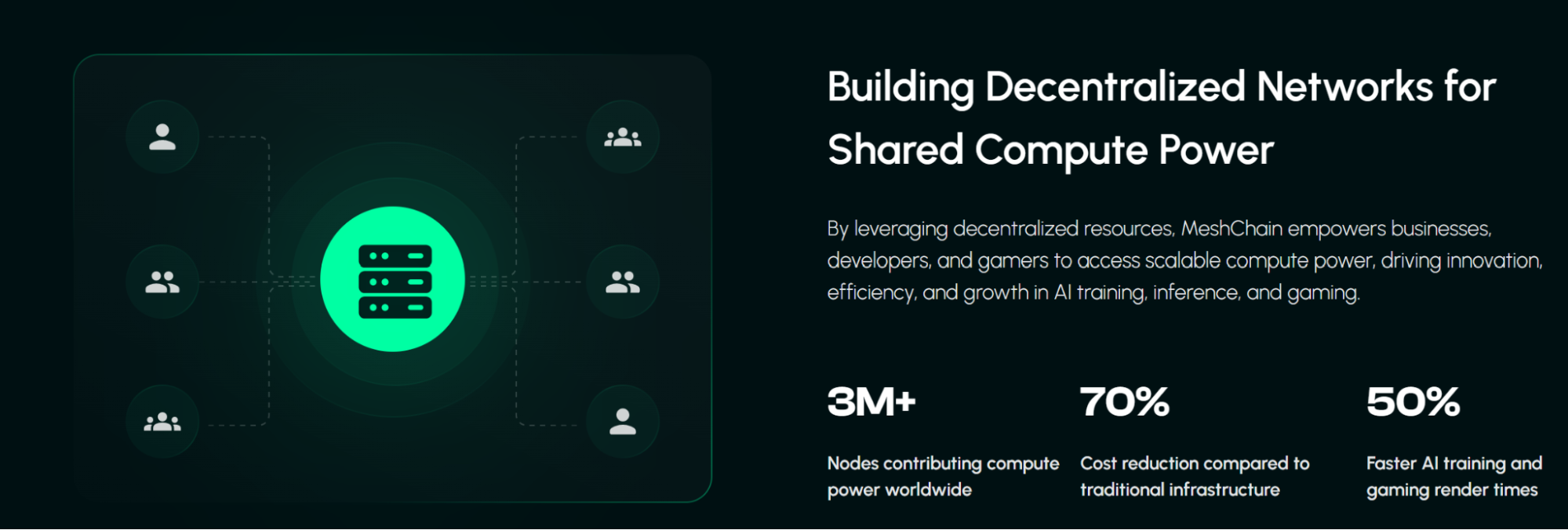
Джерело: meshchain.ai
Використання Meshchain Ai
Meshchain надає масштабовані та ефективні альтернативи традиційним централізованим хмарним провайдерам. Ці можливості можуть бути застосовані в різних галузях, починаючи від розробки та дослідження штучного інтелекту до обробки даних корпоративного рівня.
- Навчання та інференція моделі штучного інтелекту в масштабі: Meshchain дозволяє розробникам ШІ навчати та запускати інференцію на складних моделях машинного навчання, не інвестуючи в дорогий апаратний засіб або не покладаючись на централізовану інфраструктуру. Система оркестрування розбиває роботи з навчання на частини та розподіляє їх серед вузлів робітників, прискорюючи продуктивність за допомогою автоматичної паралелизації. Ця розподілена архітектура підтримує як робочі навантаження з розподіленими даними, так і модельно-розподілені, що робить її придатною для великих мовних моделей (ВММ), систем комп'ютерного зору та генеративних застосувань ШІ.
- Заробіток на бездіяльних обчисленнях для фізичних осіб та підприємств: Будь-хто з вільною обчислювальною потужністю — від особистих ноутбуків до відведених серверів — може приєднатися до Meshchain як постачальник ресурсів. Запускаючи програмне забезпечення MeshNode або розширення браузера, користувачі можуть внести свої бездіяльні ресурси у мережу та заробити токени MCC в обмін. Це створює структуру стимулів, яка перетворює не використане обладнання на пасивний дохід, а також зміцнює загальну потужність децентралізованої інфраструктури.
- Децентралізований штучний інтелект-як-сервіс для підприємств: Підприємства, які шукають більше прозорих та контрольованих за вартістю варіантів обчислення штучного інтелекту, можуть використовувати глобальну мережу Meshchain для обробки пропріетарних завдань. Бізнеси можуть надсилати завдання через CLI та виконувати їх в розподіленій мережі вузлів з блокчейном на основі аудиту та валідації. Це усуває блокування постачальників та зменшує залежність від хмарних монополій, пропонуючи як масштабованість, так і операційну прозорість.
Основні функції Meshchain Ai
Децентралізована та масштабована мережа обчислень
Meshchain усуває залежність від централізованої хмарної інфраструктури, розподіляючи робочі навантаження штучного інтелекту між глобальною мережею незалежних вузлів. Ця архітектура мінімізує поодинокі точки відмови та забезпечує справжню горизонтальну масштабованість. Meshchain динамічно розподіляє завдання на основі доступних потужностей у міру зростання вимог до обчислень, підтримуючи безперебійне навчання моделей, висновки або інші робочі процеси штучного інтелекту. Незалежно від того, чи використовують вони легкі вузли браузера або спеціальне обладнання MeshNode, учасники можуть приєднуватися або виходити, не порушуючи роботу системи. Meshchain ідеально підходить для підприємств, дослідників і незалежних розробників, яким потрібна гнучка обчислювальна потужність на вимогу без прив'язки до дорогих хмарних контрактів.

Джерело: meshchain.ai
Вартісна ефективність, глобальний охоплення та надійність
Екосистема Meshchain забезпечує високодоступну інфраструктуру штучного інтелекту, використовуючи недостатньо використані глобальні обчислювальні ресурси. Це зменшує бар'єри для невеликих розробників і стартапів, пропонуючи доступ до високопродуктивних обчислень без початкових інвестицій у дороге обладнання. Meshchain підтримує міжрегіональну доступність ресурсів через свою розподілену мережу, зменшуючи затримку та підвищуючи швидкість обробки шляхом маршрутизації завдань на сусідні вузли. Таке глобальне охоплення забезпечує послідовне, швидке та надійне виконання робочого навантаження. У поєднанні зі здатністю автоматичного масштабування залежно від попиту, Meshchain є ефективним і стійким рішенням для виконання великомасштабних або чутливих до часу завдань штучного інтелекту.

Джерело: meshchain.ai
Безпечні токени заохочення та прозорість
Meshchain використовує управління на основі блокчейну, щоб забезпечити безпеку, прозорість та перевірку всіх транзакцій та виконання завдань. Смарт-контракти вирішують розподіл завдань та нагороди у вигляді токенів MCC, надаючи пасивний дохід учасникам та сприяючи сталому зростанню мережі. Токени MCC стимулюють користувачів надавати обчислювальну потужність за допомогою пристроїв MeshNode, розширень браузера або програмних клієнтів. Усі дії безповоротно фіксуються на ланцюжку блоків, сприяючи довірі та відповідальності. Ця модель, заснована на токенах, створює активну спільноту, узгоджуючи інтереси розробників, учасників та підприємств, що беруть участь у екосистемі штучного інтелекту Meshchain.

Джерело: meshchain.ai
Обчислення наступного покоління з вузлами MeshChain
Вузли MeshChain - це спеціальні пристрої, призначені для надання обчислювальної потужності наступного покоління, оптимізованої для робочих навантажень з штучного інтелекту. Розроблені для досягнення максимальної ефективності, ці вузли дозволяють користувачам надавати обчислювальні ресурси з мінімальним споживанням енергії, забезпечуючи високу продуктивність. Налаштування просте - підключіть, налаштуйте та почніть надавати внесок за кілька хвилин. З надійністю 24/7 та інтегрованою безпекою користувачі отримують безперебійну роботу та спокій. Учасники отримують ексклюзивні винагороди за свій час роботи та внесок, що робить вузли MeshChain розумним вибором для фізичних осіб або підприємств, які шукають пасивний дохід та надійний спосіб підтримки децентралізованої екосистеми штучного інтелекту.

Джерело: meshnode.ai
Що таке МСК-монета?
MCC - це власний токен Meshchain, який працює на блокчейні та винагороджує децентралізовані обчислення штучного інтелекту. Його максимальний обсяг обмежений 1 мільярдом одиниць, з яких 500 мільйонів (заявлено самостійно) вже перебувають в обігу (березень 2025 року).
MCC виступає економічним двигуном, який забезпечує роботу децентралізованої обчислювальної інфраструктури мережі. Запущений у листопаді 2024 року разом із платформою MeshChain, MCC живить всі транзакції та операції в системі. Використовується для винагородження постачальників обчислювальних ресурсів, полегшення платежів за обробку робочого навантаження штучного інтелекту та підтримки децентралізованого управління. MCC розподіляється серед різних груп зацікавлених сторін для забезпечення збалансованого зростання, розвитку екосистеми та довгострокової стійкості.
Розподіл токенів MCC надає перевагу основним учасникам мережі. Сорок п'ять відсотків виділяється для операторів MeshNode, які забезпечують обчислювальну потужність та підтримують інфраструктуру. Стратегічним партнерствам надається 15% для стимулювання розширення екосистеми, тоді як 10% виділяється на відкритий продаж та збір коштів. Решта токенів виділяється на розвиток системи, основну команду та резервний фонд для непередбачених випадків.

Джерело: docs.meshchain.ai
Для забезпечення економічної цілісності MCC має динамічний графік відстрочення та вбудовані дефляційні механізми. До них входять спалювання токенів під час транзакцій користувачів, надходження завдань та вимоги щодо винагород. Учасники також можуть вибрати стейкінг своїх нагород MCC на 12 місяців, уникаючи плати за спалювання та підтримуючи стабільність мережі. Це сприяє довгостроковому утриманню та зменшує тиск на продаж.
Дизайн токена MCC підтримує справедливість, безпеку та прозорість. Смарт-контракти відповідають за розподіл винагород, згорання від плати за використання та контроль інфляції. Розподіл токенів для членів команди та стратегічних партнерів забезпечує довгострокову взаємодію. Токен також є центральним для управління, дозволяючи спільноті брати участь у прийнятті рішень. MCC є критичним компонентом децентралізованої інфраструктури обчислень штучного інтелекту MeshChain, забезпечуючи стимули та механізми, необхідні для підтримки глобальної, спільнотної мережі.
Чи є MC хорошим інвестицією?
MCC пропонує можливість отримання доступу до зростаючої ніші на перетині штучного інтелекту та децентралізованого обчислення, що може бути привабливим у зв'язку зі зростанням попиту на обчислювальну потужність. Токен підтримує екосистему Meshchain, стимулюючи глобальних постачальників ресурсів за допомогою стейкінгу та винагород на основі використання, в той час як він включає дефляційні механізми, такі як зжигання при транзакціях та вимогах на винагороди. Однак ризики включають волатильність ринку, конкуренцію з більш встановленими децентралізованими обчислювальними мережами та виклик підтримання попиту від розробників штучного інтелекту. Як і з усіма утилітними токенами, довгострокова вартість MCC залежить від прийняття, використання мережі та здатності команди ефективно виконувати дорожню карту.
Як володіти MCC?
Щоб володіти MCC, ви можете скористатися послугами централізованої криптовалютної біржі. Почніть зстворення облікового запису Gate.com, і отримаєте його перевіреним та фінансованим. Після цього ви будете готові пройти кроки для покупки MCC.
Новини про Meshchain Ai
Як повідомлялося 27 лютого 2025 року через офіційний канал X, MeshChain AI представила функцію обміну в MeshChain Wallet, яка дозволяє безперешкодно конвертувати MCC та USDT. Тепер користувачі можуть миттєво обмінювати без покладання на сторонніх постачальників, фіксуючи прибуток або перерозподіляючи активи в залежності від ринкових умов. Ця функція підвищує ліквідність, оптимізує комісії та забезпечує повний контроль над активами, надаючи безпечний, ефективний та зручний досвід для спільноти MeshChain.
Пов’язані статті
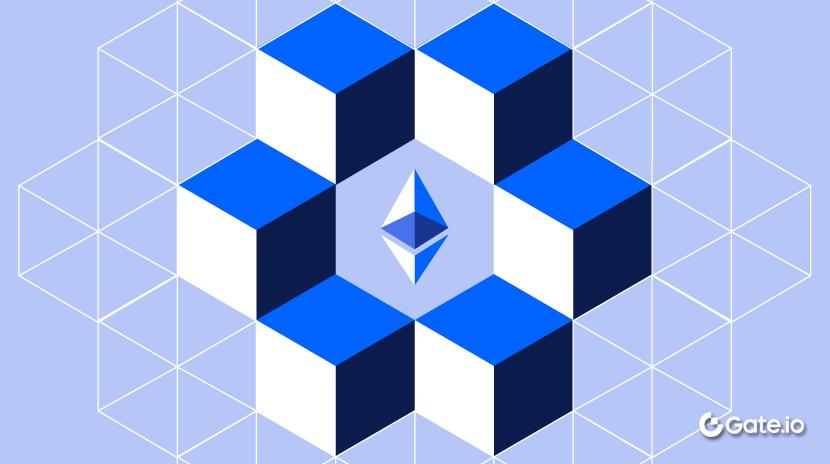
Як поставити ETH?
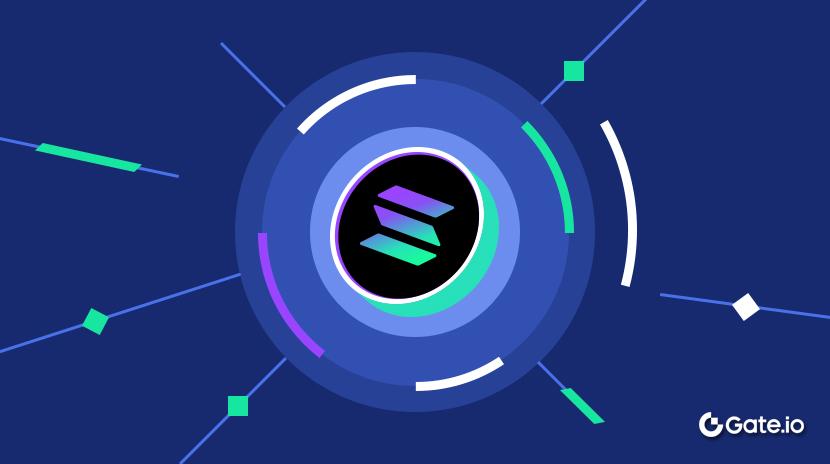
Що таке Солана?

Що таке Coti? Все, що вам потрібно знати про COTI
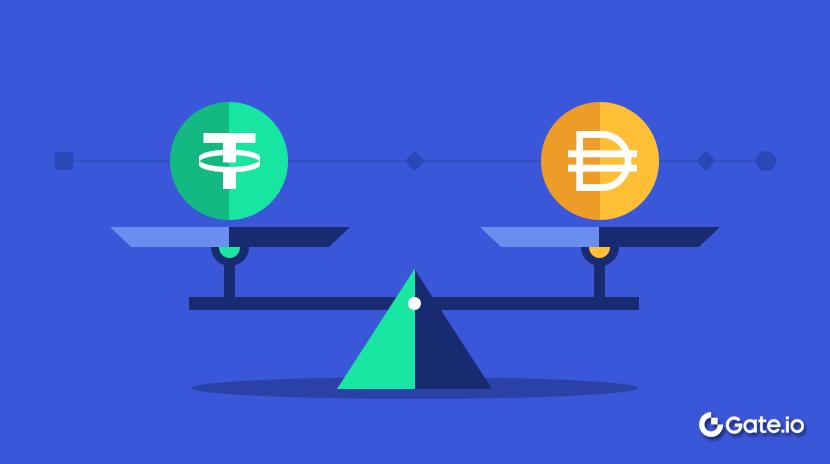
Що таке Стейблкойн?
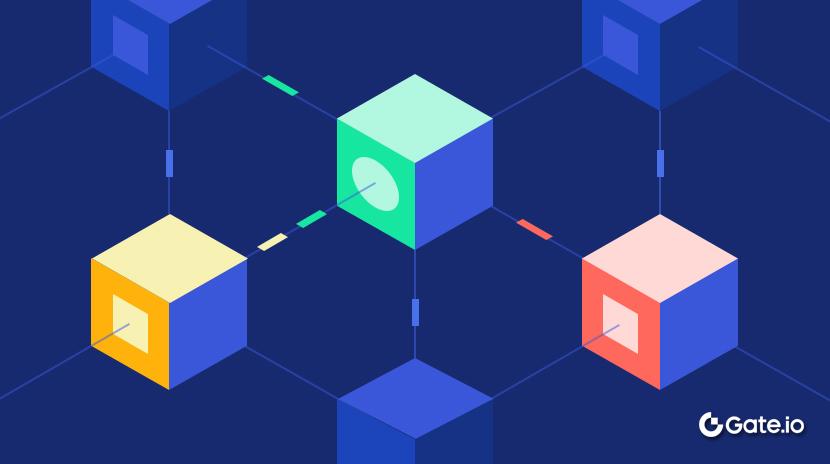
Все, що вам потрібно знати про Blockchain
